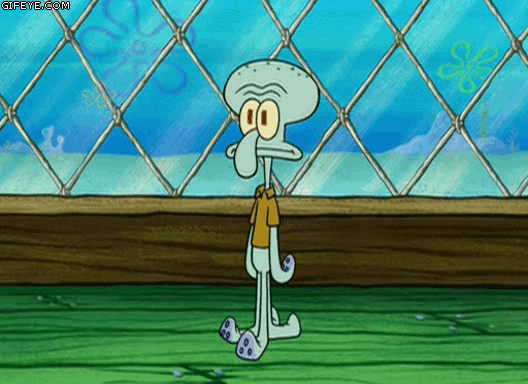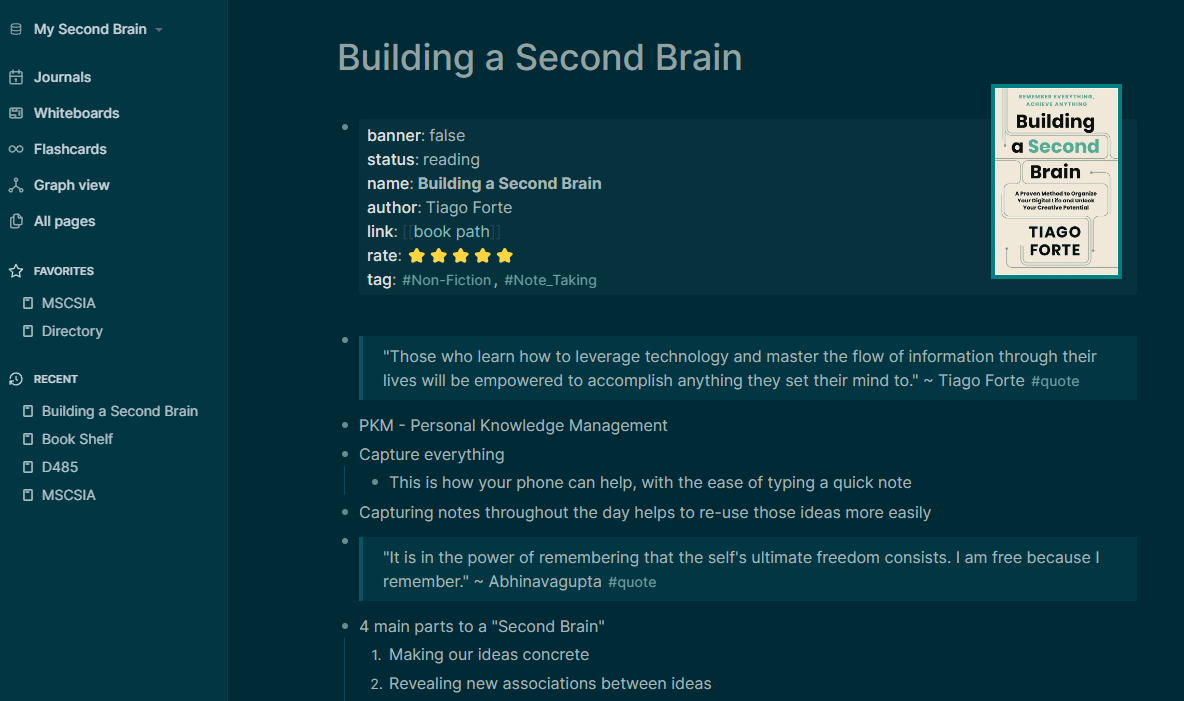
So for 2024, I’m hoping to focus more on reading. I have gotten a little more serious as of December 2023, and one of those books that I “got serious” about was “Building a Second Brain” by Tiago Forte. Before I really started this book, I had identified that something needed to change when it came to my current note taking strategy. I’ve just started a new job over at Mohawk Industries, and I noticied that there were a lot of things that I was missing by not being able to find the notes I took on them. I honestly felt like Squidward, just dumping knowledge at some point and not really realizing where it went.
Those who learn how to leverage technology and master the flow of information through their lives will be empowered to accomplish anything they set their mind to.
~ Tiago Forte
A “Second Brain” is really something meant to just offload your thoughts into, so you can connect thoughts together in your main brain (the one inside your head). Our brain is beautifully built by God with the ability to create, so why not use it for what it was most intended for – creativity. By freeing up our mind to think more creatively, we can then build better products quicker, and more efficently. While I didn’t believe it while I was reading it, he mentioned that there would come a point in which most of your research can actually be done in your notes alone, and I’ve actually found that to be the case. It’s amazing not having to scour the web and all the ads it has to distract you, when you can just go to all your notes.
To have all those notes though, you need to capture notes. One important item that Tiago talks about is how you should be able to access your notes at all times of the day. This will help you to truly capture thoughts whenever they come up. Maybe after your commute where you listen to a podcast (shoutout The WAN Show), maybe you took your dog out for a walk and saw a fence style you like, anything! Anything can prompt a great idea, so it’s important to have a second brain that can capture that thought at any time.
Going outside of the book for a second, my current solution is Logseq paired with Syncthing. Logseq is a privacy-focused note taking app, that just uses structured markdown files. They give you a fairly fast platform, where you can put any notes or build whatever page you want. There are also plugins that you can install from other users in order to extend the functionality.
 An example of Logseq using my notes from the book
An example of Logseq using my notes from the book
The second part of my setup is Syncthing. Logseq is privacy focused, and as such they want you to be the person to decide how you sync your notes. You can use anything for this, Google Drive, OneDrive, DropBox, Github (it even has some extra niceness like autocommit for autosaving). But I chose to go with Syncthing. It’s a local app that I have on my phone, my laptop, and my desktop that allows me to sync between the devices, rather than all syncing to a server I don’t own. It’s seemless, but can be slightly complex to set up for the first time.
Back to the book though! Tiago goes over a concept of “CODE” that I really enjoy, it stands for Capture, Organize, Distil, and Express. This is what the ideal life cycle of your notes should be. You need to capture the raw ideas as they come about during the day, organize your notes into a system that I’ll touch on a little later, distil your notes down to the key ideas, and then express them in some way. It’s a great lifecycle to keep in mind while you take you take notes in your everyday. The express part is huge, as that is ultimately what your notes are for at the end of the day.
For organizing your notes, there is a system he denotes called “PARA”, which stands for Projects, Areas, Resources, and Archive. Projects are for anything that you are actively working on. Areas are for items that you’re not directly working to completion, but you’re responsible for. Resources are for items that don’t have a deadline or not responsible for, but it’s still important. And then finally, your archive can encompass any notes that don’t serve a use at the current time. I’ve actually used this to organize my documents as well as my notes, and it has been great. I can finally easily reach things in my Google Drive, either by searching or by logically knowing what my criteria is for each section and being able to navigate to it quickly.
The final item in this book that I found to be useful is the idea of Weekly/Monthly reviews of notes. Your weekly review is meant for a “practical” review, meaning that you organize any notes you havent yet, clear your e-mail, etc. And then your monthly review is aligining your goals with what you have, updating project lists and reviewing someday tasks. I’ve not done anything like that before, but it’s something I’m trying this new year, and we’ll see how it goes.
Overall, I love this book. I think it’s a great book that a lot of people should read in today’s world. Too many times I find that people aren’t taking notes, reducing the efficency of meetings. This allows me to prepare for meetings in about 5 minutes, reviewing notes quickly and efficently. It’s helped me a lot, and I hope that others put this book into their list to read. He does a great job of illustrating how to take notes in the digital age.
I’d love to read your comments on this! Are you gonna read this? Is there something else I should read/post about? Leave a comment below. Happy reading!